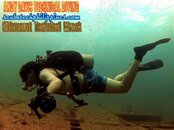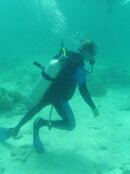The Chairman
Chairman of the Board
Two of my absolute favorite topics to teach are propulsion and trim/neutral buoyancy. Yes, they are what matter most to me when teaching OW and my students would never have to take such a class. However, I am constantly reminded when diving and seeing how others dive, that my concept of trim and neutral buoyancy don't match many of the divers I see kicking around on the reef. I was teaching such a class this past weekend, and I had the temerity to ask few people on the boat how they felt about their skills in this respect. All of them thought they were well above average. All of them. The guy who left a trail of silt everywhere he went? "I'm pretty comfortable keeping off the reef". The guy who left an impact crater under the boat? "You've got to be neutral! I believe in that." The lady kicked, gorgonians, fans, corals, you name it? "My instructor was pretty militant about us staying above the reef." It was obvious from the interactions that the only one on the boat who thought they had a problem with propulsion, trim and buoyancy was my student. She was also the one who made the least impact on the reef.
Here's the sad part, my student had done two "refresher" courses with her dive shop and she still felt she needed work. I asked her how she knew she still needed help and the answer was simple: a photograph. She saw her trim compared to other divers and she didn't like what she saw. She also felt somewhat uncomfortable (out of control?) while she was diving. The happy part is that she identified her need and did something about it.
Still, the vast majority of divers need help and yet they seem clueless about that fact. Sure, a part of it boils down to pride and some of comes from out and out denial. I think a lot of it just stems from simple ignorance. The divers who need help simply don't know what's acceptable. Now, you might be wondering if you need to take a class like this, and so I'm going to make a list of "tell tale" signs that might aid you in evaluating your diving.
Make no doubt about it. If you fall into one or more of these categories, you don't have to take a class. You can work all of this out on your own or with a mentor(s). There are a number of instructors who don't get it either, and obviously taking this class from them will do wonders for your ego, but not a whole lot for your skills. Personally, I consider this a remedial class. I won't make you feel embarrassed about it, but you'll find a lot of what we do is go through your OW skills one by one with the goal of getting you comfortable and neutral. Every instructor is different, so don't sweat it if they teach on a different trek.
Make no doubt about it #2. If you take a class like this, your diving is still up to you. We can only give you the tools to shape your dive. You'll have to take these tools and start to implement and refine them as you dive. My students usually notice an immediate decrease in their SAC and an increase in their bottom time, but I would be a fraud if I suggested that your SAC would drop to .4 overnight or even at all.
Here's the sad part, my student had done two "refresher" courses with her dive shop and she still felt she needed work. I asked her how she knew she still needed help and the answer was simple: a photograph. She saw her trim compared to other divers and she didn't like what she saw. She also felt somewhat uncomfortable (out of control?) while she was diving. The happy part is that she identified her need and did something about it.
Still, the vast majority of divers need help and yet they seem clueless about that fact. Sure, a part of it boils down to pride and some of comes from out and out denial. I think a lot of it just stems from simple ignorance. The divers who need help simply don't know what's acceptable. Now, you might be wondering if you need to take a class like this, and so I'm going to make a list of "tell tale" signs that might aid you in evaluating your diving.
- High SAC rate (over .7). Let's face it. One of the most obvious things about a person who has not mastered neutral buoyancy is that they are "air hogs". They are almost always the first to call a dive. Sure, there are some tiny little women who don't have a clue about neutral buoyancy who dive longer than some. There will always be exceptions, but if your SAC (Surface Air Consumption) is high, then you probably need help.
- Scuffed fins. Sure, they get a few scuffs out of the water, but your fins should not look like they've been through WWIII. Are they old and scuffed from previous dives? Put a thin coat of paint on them that contrasts with your fin color. Check them after your dives.
- Non posed pictures. Ask your buddies to take a candid shot or two of you while diving. This should be indicative of your normal attitude in the water. If a picture is worth a thousand words, then a video is worth nigh on to a million. Break out the Go Pros and swap taking vids of each other.
- Look ma, no hands! Can you make an entire dive without sculling with your hands? Of course, I've had the worst hand scullers claim that they just don't do that. It's an unconscious thing and perhaps it will take a video to convince you that you are a sculler.
- Gittin' froggy with it! If your predominant kick or only kick is the flutter then consider taking such a class.
- Personal tests. Go to a pool and attempt the following:
- Blind neutral hover. Get comfortable about a foot off of the bottom. Close your eyes and hold your position for 20, 40 and then 60 seconds. Where are you in respect to where you started?
- Mask R&R. Get comfortable about a foot off the bottom. Take your mask off and breathe 5 cycles. Replace the mask. Where are you in respect to where you started? You can vary this with reg recovery, OOA etc.
- BCD R&R mid water. Can you do this?
- Ask your buddy! But remember, if his trim is poor, he might give you a glowing review. In that case, suggest that you take the class together.
- Unsolicited comments from other divers. There is always going to be an occasional criticism about how you dive. If these criticisms seem to be constant and incessant, then get some help.
- Your significant other dives, but you don't enjoy it! If you feel out of control or even unsafe, then find one of these classes.
Make no doubt about it. If you fall into one or more of these categories, you don't have to take a class. You can work all of this out on your own or with a mentor(s). There are a number of instructors who don't get it either, and obviously taking this class from them will do wonders for your ego, but not a whole lot for your skills. Personally, I consider this a remedial class. I won't make you feel embarrassed about it, but you'll find a lot of what we do is go through your OW skills one by one with the goal of getting you comfortable and neutral. Every instructor is different, so don't sweat it if they teach on a different trek.
Make no doubt about it #2. If you take a class like this, your diving is still up to you. We can only give you the tools to shape your dive. You'll have to take these tools and start to implement and refine them as you dive. My students usually notice an immediate decrease in their SAC and an increase in their bottom time, but I would be a fraud if I suggested that your SAC would drop to .4 overnight or even at all.
Last edited:






